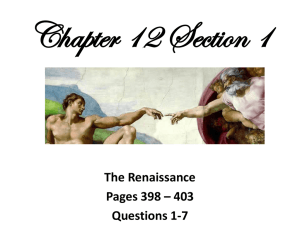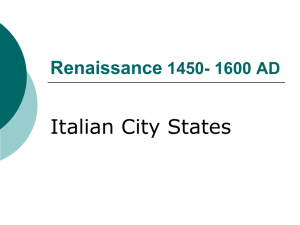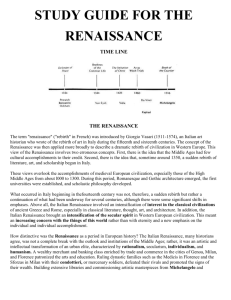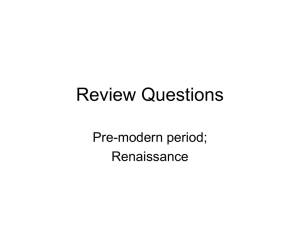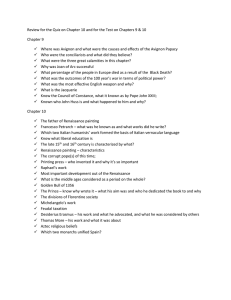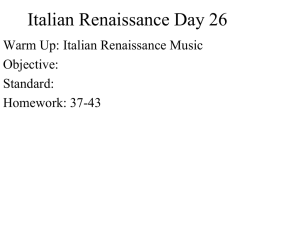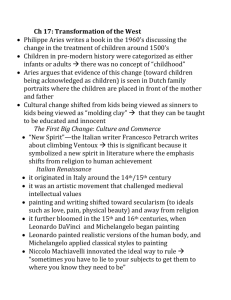AP European History: Renaissance Practice Quiz
advertisement
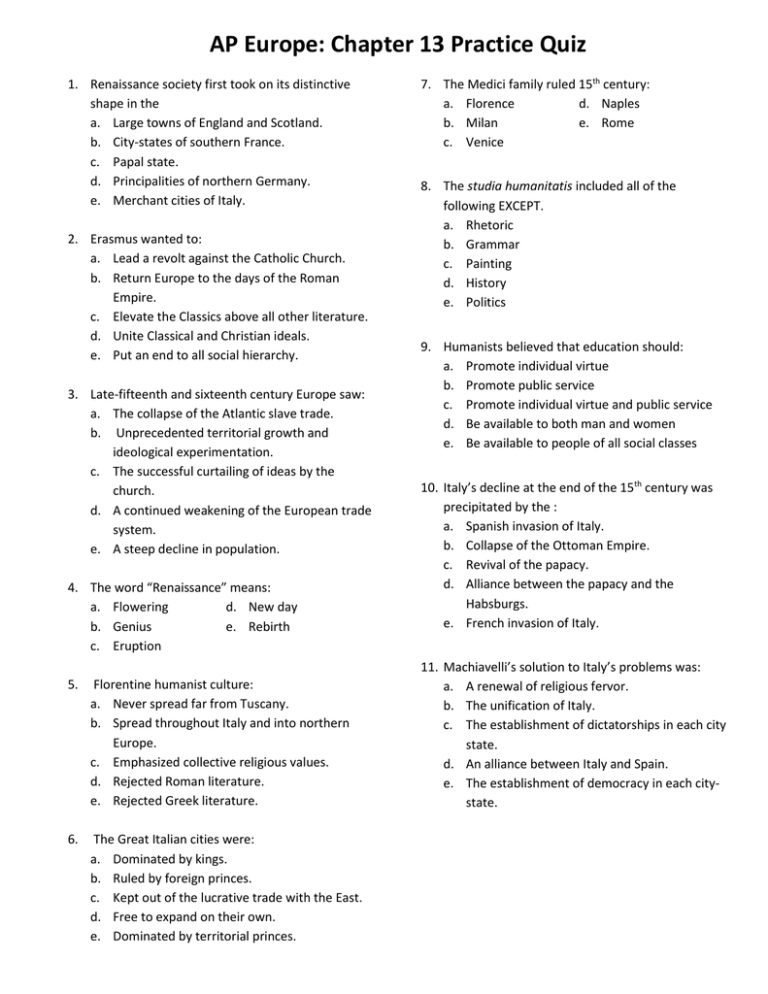
AP Europe: Chapter 13 Practice Quiz 1. Renaissance society first took on its distinctive shape in the a. Large towns of England and Scotland. b. City-states of southern France. c. Papal state. d. Principalities of northern Germany. e. Merchant cities of Italy. 2. Erasmus wanted to: a. Lead a revolt against the Catholic Church. b. Return Europe to the days of the Roman Empire. c. Elevate the Classics above all other literature. d. Unite Classical and Christian ideals. e. Put an end to all social hierarchy. 3. Late-fifteenth and sixteenth century Europe saw: a. The collapse of the Atlantic slave trade. b. Unprecedented territorial growth and ideological experimentation. c. The successful curtailing of ideas by the church. d. A continued weakening of the European trade system. e. A steep decline in population. 4. The word “Renaissance” means: a. Flowering d. New day b. Genius e. Rebirth c. Eruption 5. Florentine humanist culture: a. Never spread far from Tuscany. b. Spread throughout Italy and into northern Europe. c. Emphasized collective religious values. d. Rejected Roman literature. e. Rejected Greek literature. 6. The Great Italian cities were: a. Dominated by kings. b. Ruled by foreign princes. c. Kept out of the lucrative trade with the East. d. Free to expand on their own. e. Dominated by territorial princes. 7. The Medici family ruled 15th century: a. Florence d. Naples b. Milan e. Rome c. Venice 8. The studia humanitatis included all of the following EXCEPT. a. Rhetoric b. Grammar c. Painting d. History e. Politics 9. Humanists believed that education should: a. Promote individual virtue b. Promote public service c. Promote individual virtue and public service d. Be available to both man and women e. Be available to people of all social classes 10. Italy’s decline at the end of the 15th century was precipitated by the : a. Spanish invasion of Italy. b. Collapse of the Ottoman Empire. c. Revival of the papacy. d. Alliance between the papacy and the Habsburgs. e. French invasion of Italy. 11. Machiavelli’s solution to Italy’s problems was: a. A renewal of religious fervor. b. The unification of Italy. c. The establishment of dictatorships in each city state. d. An alliance between Italy and Spain. e. The establishment of democracy in each citystate. AP Europe: Chapter 13 Practice Quiz 12. The marriage of Ferdinand of Aragon and Isabella of Castile allowed the two rulers to do all of the following EXCEPT: a. Subdue unruly elements in the realms. b. Secure their borders against attacks. c. Secure a lasting peace with Muslim Spain. d. Christianize the whole of Spain. e. Venture abroad militarily. 17. Which Renaissance text best exemplifies the Renaissance ideal of multitalented, well trained individual? a. Castiglione’s The Courtier b. More’s Utopia c. Machiavelli’s The Prince d. Erasmus’s In Praise of Folly e. Boccaccio’s Decameron 13. Compared to Italian humanists, northern humanists were more devoted to ________ reforms. a. Political d. Religious b. Social e. Linguistic c. Intellectual 18. Northern Renaissance art differed from it Italian counterparts in that a. It was less religious. b. Its architecture was little influenced by Italian Renaissance architecture. c. It was less detailed. d. It was more religious. e. Its paintings rarely used perspective. 14. Renaissance Italians used permanent resident ambassadors as diplomats in order to a. unify their responses to the threat of French invasion. b. help the papacy. c. create alliances and preserve a balance of power. d. deal with the Ottoman threat. e. prevent the kingdom of Naples from being taken over by the king of Aragon. 15. Women during the Renaissance were a. Generally excluded from artistic and literary circles. b. Accepted as humanists but not as artists. c. Accepted as artists but not as humanists. d. Rarely discussed in educational texts. e. Important for their roles as patrons of major artworks. 16. Blacks in Renaissance Europe a. were extremely rare. b. were used for both slave and wage labor. c. had been imported into Portugal from Africa but were isolated there. d. were almost always employed as entertainers. e. were vilified since black was always seen as a negative color. 19. Machiavelli differed from medieval political theorists in that he wrote about a. the morality of the prince. b. the importance for a prince to win over the masses. c. how political life operates, not how it should be. d. the importance for the prince to come to terms with the church. e. how the prince must engage in immortal behavior. 20. In the typical northern Italian commune, a. people owned property in common. b. the entire male adult population had the franchise; women did not. c. nobles ruled as princes. d. the ruling families had similar interests and rarely fought each other. e. merchant oligarchies held power.
